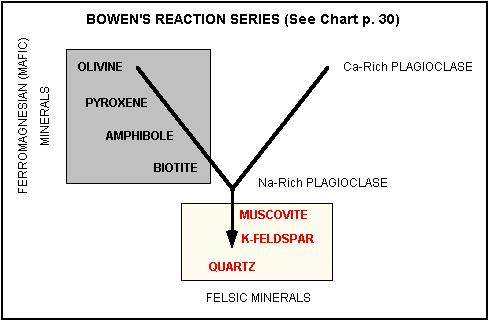
| Lecture Notes |
Igneous rocks are formed when molten rocks solidify (crystallize).
MAGMA - is a silicate melt that contains crystals and dissolved volatiles
MAGMAS when cooled form PLUTONIC (also termed INTRUSIVE) igneous rocks
LAVAS when cooled form VOLCANIC (also termed EXTRUSIVE) igneous rocks
* Jump Up to Igneous Topics Listing *
Different magmas have different viscosities. Viscosity is the property of a substance to internally resist flow.
Why do magmas have different viscosities?
Why are some eruptions from volcanoes explosive while others aren't?
* Jump Up to Igneous Topics Listing *
Igneous rocks are CLASSIFIED according to their mineral composition and texture.
Minerals form as molten rock crystallizes. A generalized order of crystallization of minerals is shown in the Bowen's Reaction Series. As the magma cools, first olivine, then pyroxene, then amphobole, etc. will be crystallized (assuming the proper elements are available). Please note that this is a very simplified progression, but still useful to help us discern some trends.

THE BOWEN'S REACTION SERIES
· Shows a generalized crystallization order of minerals as a magma cools.
GENERALITIES down the reaction series (from top to bottom):
FELSIC rocks - typical colors include: white, pink, and colorless
MAFIC rocks - typical colors include: black and gray
ULTRAMAFIC rocks - typical colors include: olive green and black
* Jump Up to Igneous Topics Listing *
Crystal Size:
Porphyry (p. 108): Describes an igneous rock where coarse crystals (called PHENOCRYSTS) and fine grained crystals (termed GROUNDMASS) exist together in an igneous rock.
Pegmatite: Describes an igneous rock where ALL crystals are pegmatitic (> 1 cm) in size.
* Jump Up to Igneous Topics Listing *
If your igneous rock sample displays...
What if I have both fine-grained and coarse-grained crystals in a rock (a Porphyry)?
Since lava cools quickly at the earth's surface, VOLCANIC rocks will have a texture of: no crystals, fine-grained crystals, or a mixture of fine-grained and coarse-grained (porphyry).
Conversely, since magma cools very slowly deep within the earth, PLUTONIC rocks will have a texture consisting of coarse-grained crystals or pegmatitic crystals.
* Jump Up to Igneous Topics Listing *
Felsic |
Mafic |
Ultramafic |
|||
Volcanic |
Glass |
Obsidian; Pumice |
|||
Fine-grained |
Rhyolite |
Basalt; Scoria |
|||
Fine & Coarse |
Andesite Porphyry |
||||
Plutonic |
Coarse-grained |
Granite |
Gabbro |
Peridotite |
|
Pegmatitic |
Granite Pegmatite |
||||
NOTE: On this chart, blue names are the igneous rock types. Italicized rocks indicate the presence of vesicles (remnant gas bubbles).
Example on how to use this table:
Let's say you find a black and gray igneous rock in which all of the grains are small, but easily seen with the naked eye. The gray and black colors are indicative of a mafic rock mineralogy (plagioclase = gray, augite/hornblende = black). The fact that you can make out individual mineral grains indicates a coarse-grained texture. Using the chart, locate the Mafic column and find where it intersects the Coarse-grained row to get the rock name. From the chart, we determine that this rock is called GABBRO (a Plutonic rock).
* Jump Up to Igneous Topics Listing *
* Jump Up to Igneous Topics Listing *
* Jump Up to Igneous Topics Listing *
Tuff: explosively formed, fine grained volcanic rock welded together
* Jump Up to Igneous Topics Listing *